|
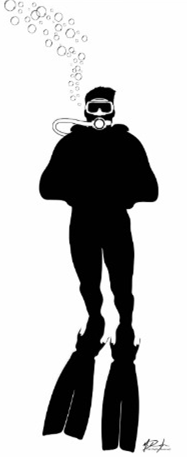

Dive Log
Back to

Back to

|
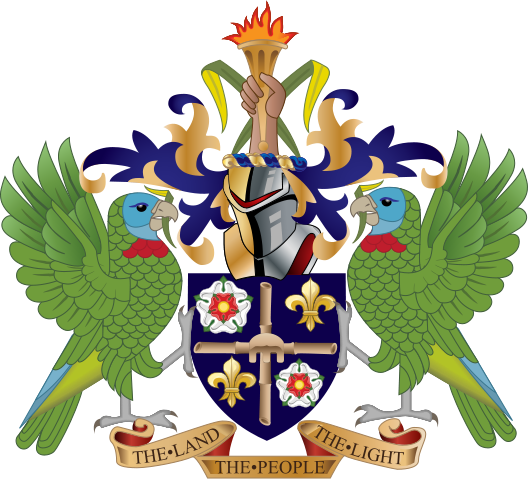
St.
Lucia
August, 1985
When you've got a winning combination, why
mess with anything else? That's the way we felt as we were
selecting a dive operation in 1985. If you've been keeping
track, you'll notice there isn't an entry for for 1984. To
make a long story short, I had left my job in 1983 to go back to
school for one year to pick up my teaching certification; in
hindsight it wasn't worth the loss of a dive trip. But
anyway, we decided to try the Windward Island chain and began by
looking to see if Peter Hughes had an operation on any of the
islands. We chose St. Lucia.
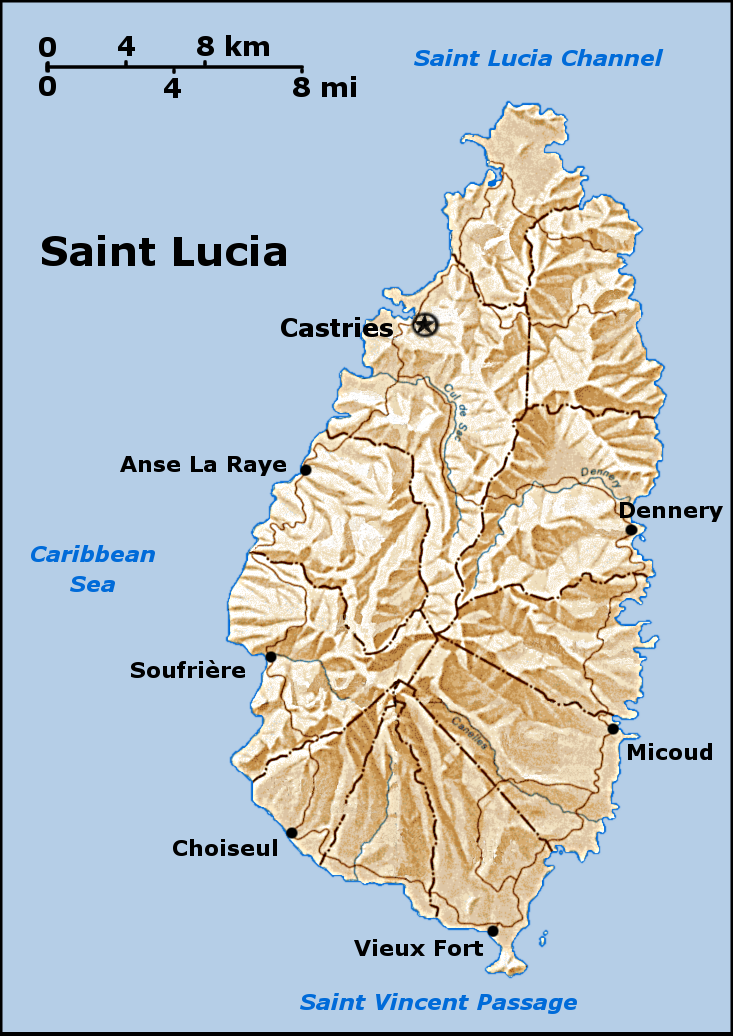
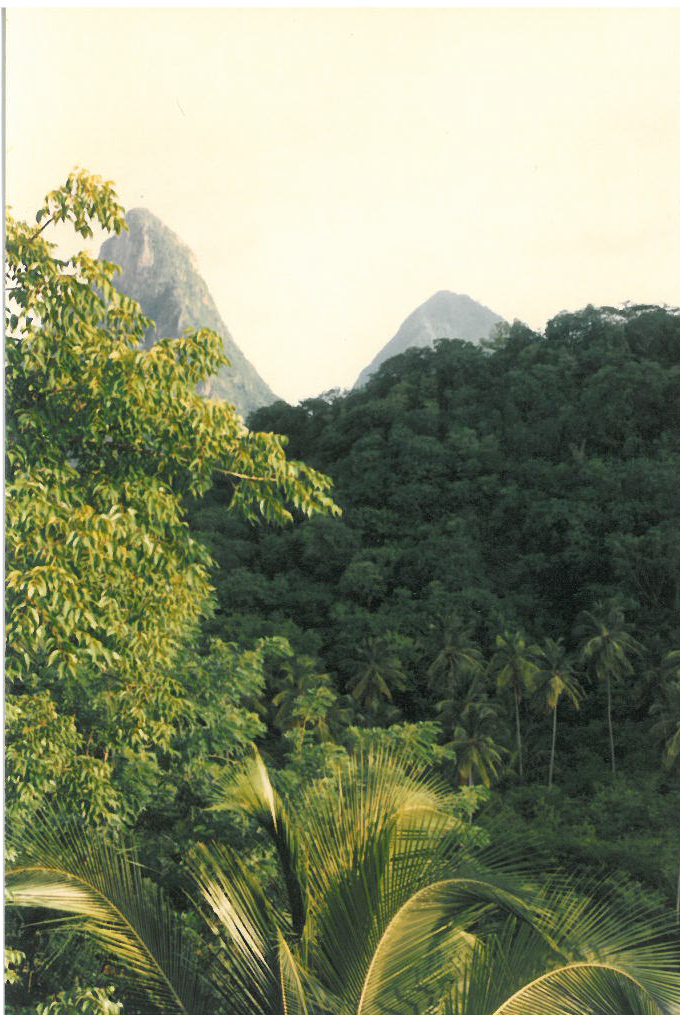 |
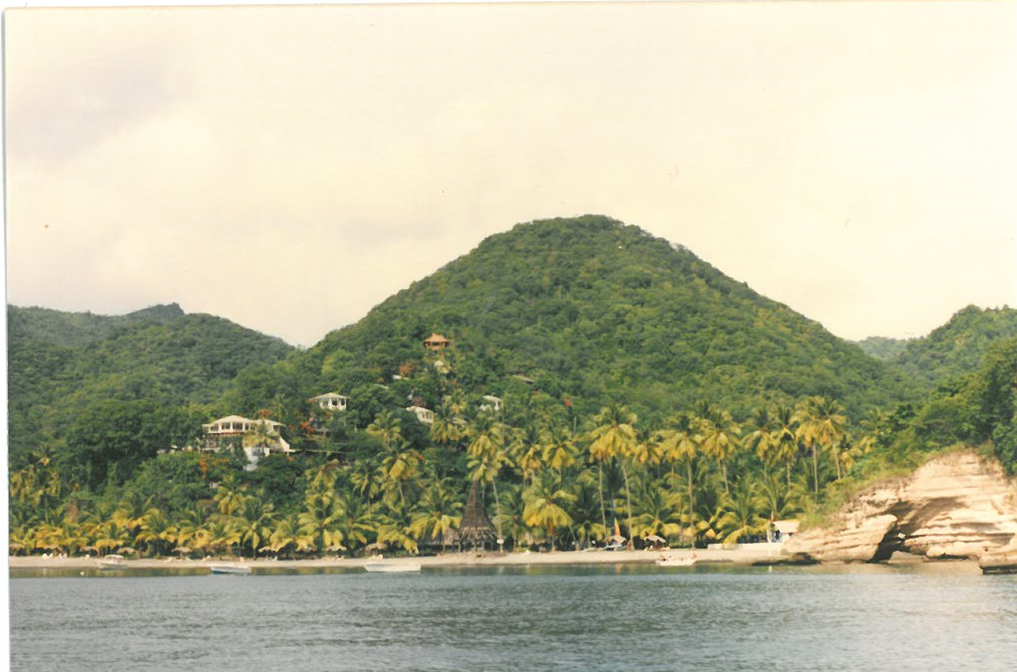
Anse Chastanet on St. Lucia was
the selection we made; and a fine choice it was.
For the movie buffs, you might remember a scene in
Superman II where the Man of Steel flies to an island to
pick an exotic flower for Lois Lane. Well, he
picked it on the island of St. Lucia. Of all the
island we picked to date, St. Lucia was the
stereotypical tropical island; lush rain forest, cool
sea breeze, and a pair of volcanic peaks - known
as the Pitahs - shrouded in clouds. We could
almost hear the jungle drums.
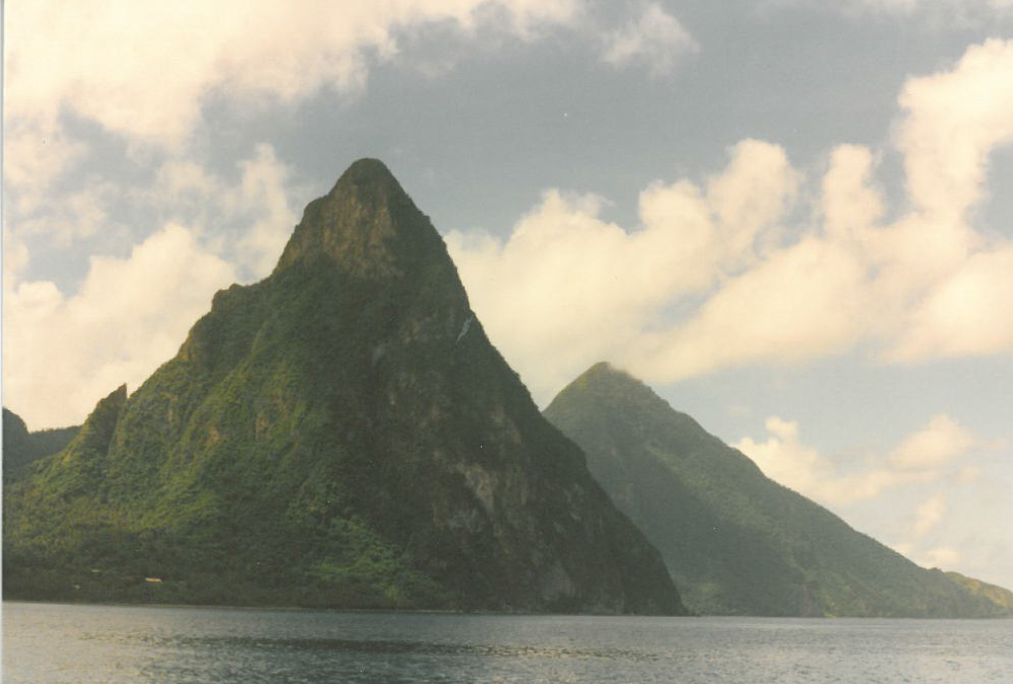
The one item that didn't fit the
perfect island profile was the sand. St. Lucia -
being volcanic - had sand beaches that were of black
sand. When we dove, the sand between the coral
heads was predominately black . And the
beaches...we thought of Dudley Moore in "10" where he
was running across the hot sand.
The airport scene has already been
described from earlier trips so I won't go over that
aspect again. The trip to the hotel from the
airport was a bit different WE arrived at the
island just as the sun was setting and climbed into the
back of a Land Rover equipped to carry dive tanks.
The road to the hotel was winding, jarring, and
extremely narrow with many areas of shear deadfall
drops. If one vehicle met another, it was quite a
maneuver to get around safely. The drive was long,
so we struck up a conversation with the you man who
served as our cabbie. His English was quite good
and we learned a lot about the education, industry, and
history of the island. |
|
A bit of history...
The French were the
island's first European settlers. They signed a treaty with the
native Carib Indians in 1660. England took control of the island
from 1663 to 1667. In ensuing years, it was at war with France
14 times, and rule of the island changed frequently (it was
seven times each ruled by the French and British). In 1814, the
British took definitive control of the island. Because it
switched so often between British and French control, Saint
Lucia was also known as the "Helen of the West Indies".
Representative
government came about in 1840 (with universal suffrage from
1953). From 1958 to 1962, the island was a member of the
Federation of the West Indies. On 22 February 1979, Saint Lucia
became an independent state of the Commonwealth of Nations
associated with the United Kingdom. |
We arrived in the dark
at the upper lobby of the hotel where our luggage was unloaded
and we received our briefing. Anse Chastanet was a
relatively new operation at the time complete with tennis
courts, hiking trails, luxurious rooms, fine dining, and all the
other amenities that make a hotel an attraction for divers and
non-divers alike. The hotel did have one characteristic
that is notable above others. To get from the rooms that
were built into the mountainside overlooking the ocean down to
the dive operation on the beach, you had to descend over 100
winding stone steps. Likewise, to get back to your room
required a healthy climb. Needless to say, we planned our
days to limit the number of trips up and down the mountain to
our room.
We generally ate a
continental breakfast of fruits and breads, cereal, and eggs
with toast each morning and gathered our regulators, masks,
towels, sunscreen, and whatever else we thought we might need
before trekking down to the dive shop. We averaged two
dives a day; one in the morning, ate lunch at the dining area on
the beach, a second dive in the afternoon, lounge around the
beach or snorkeled, and back up the mountain for dinner.
Upon arrival, our dive
gear - with the exception of our masks and regulators which we
kept - were loaded onto the shoulder of one of the staff and
taken down to the dive shop each morning. Thank God!
At that time, all of our dive gear - including weight belts -
was wrangled into one large nylon bag that the two of us
struggled to carry. Diving is not a lightweight sport.
The equipment is heavy everywhere but under water.
The dive operation, as I
mentioned, was owned by Peter Hughes and was managed by Wayne
and Karen Brown. Peter Jackson and Charles were the Dive
Masters and Mark was the general muscle of the outfit,
Everything was clean and the daily routine of running the dive
shop ran like clockwork. We could sign up for a dive, show
up at the boat, and off we would go.
Our beach checkout dive
was a good start to an excellent week of diving. We dove a
cave where we came up into a pocket of air. The Dive
Master spotted an octopus; the first of several on this trip.
We swam into a large school of sergeant majors (the fish not the
military) and played with several banded shrimp. The
afternoon dive was to be at "Cay" at 2 PM. We entered the
rolling seas for fifty minutes of breathtaking beauty. It
was a wall dive at an average depth of 40 feet. Visibility
was 100 feet or more and we saw a small moray eel, sea
cucumbers, large sea biscuits, spotted drums, and arrow crabs.
The current was very strong, but when we ran out of air, we just
surfaced and the boat was there to pick us up. It doesn't
get any better than that.
Dining at the Anse
Chasteenet was superb! Shrimp, shrimp, and more shrimp; in
cocktails, cold salads, fried, broiled, anyway you can imagine.
I've already described breakfasts with the banana quits and here
a darker more aggressive finch would perch nearby looking for
scraps. The birds were territorial which included specific
tables. It was all quite amusing for the first few days;
then it became matter-of-fact.
Lunch was down at the
beach in a long open hut serviced by the staff. Our
selection was typically American; burger, fries, and a Coke.
After trying several other selections, this was the tastiest and
the least expensive. Lunch would take an hour whether you
wanted it to or not.
Dinner was relaxed.
The dining area on the upper terrace was open and small but the
food was excellent. Our waitress for the week was a lovely
young woman; an English major from Toronto who was somehow
related to the owners. The rum drinks were potent, the
beer had a tasty bite, and the meals were always gourmet.
Unfortunately, a dive log doesn't contain space for what the
menu was for the day or what special events took place so I have
to rely on a failing memory.
On August 12, we
picnicked. Our first dive was "Superman"; named for the
strong currents that made you fly over the reef.
Fortunately for us, the conditions were not bad that day.
We saw immense spiny lobsters and huge tube worms.
Regardless of the current, it was still a drift dive and the
boat picked ups up in a cove in front of an old copra
plantation. The owner at the time was a former fling of
Princess Margaret and the plantation was a menagerie of animals
from goats and chickens to burros...and an elephant named Bupa.
Bupa was just a baby then, but it had learned to come running to
the beach for bananas fed to it by the divers. It looked
out of place cooling its packaderm toes in the ocean.
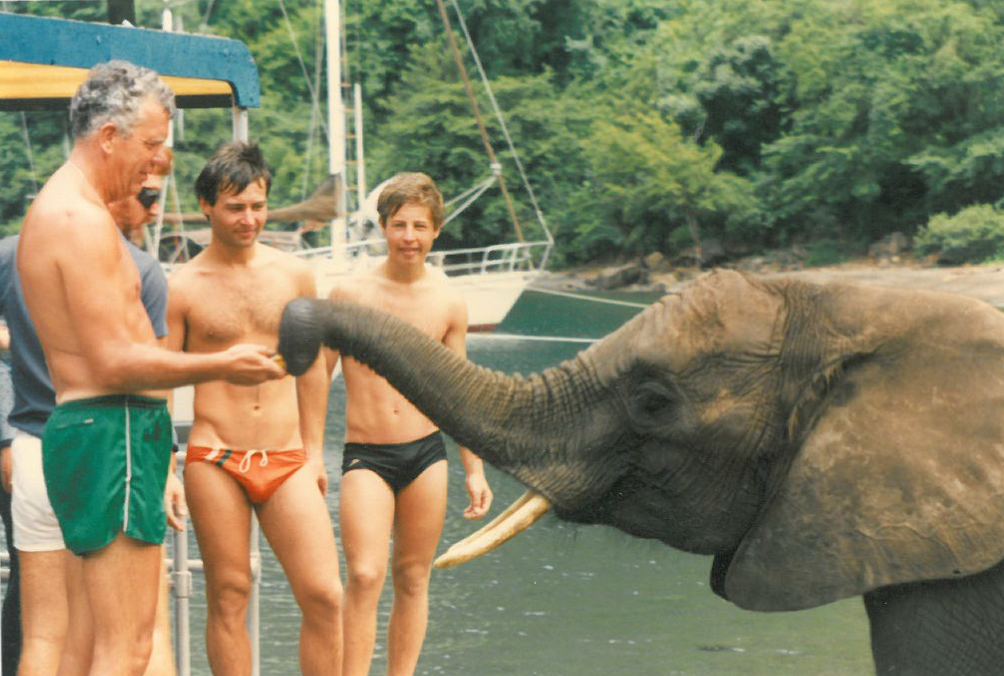
Lunch was a bar-b-q with
the typical American fixings. We had a few hours to relax
before our second dive at "Turtle Reef"; which was straight out
from the beach. We were ferried out in the boat and swam
our way back towards the beach. Along the way we saw sand
dollars and sea biscuits, scallops, and sea cucumbers (sounds
more like a salad than a dive).
That evening we made a
night dive from the beach where we saw numerous lobsters, crabs,
moray eels, squid, and slipper lobsters.
|
Slipper lobsters are a family of decapod crustaceans
found in all warm oceans and seas. Despite their name,
they are not true lobsters, but are more closely related
to spiny lobsters and furry lobsters. Slipper lobsters
are instantly recognizable by their enlarged antennae,
which project forward from the head as wide plates. All
the species are edible, and some, such as the Moreton
Bay bug and the "Balmain bug" are of commercial
importance.
"Coral
Gardens" and "Keyhole Pinnacles" were lovely reefs and
lovely dives. Keyhole is were I saw my first lion
fish. I had gotten good at locating and avoiding
stone fish, but this was the first time I had seen their
more poisonous cousin.
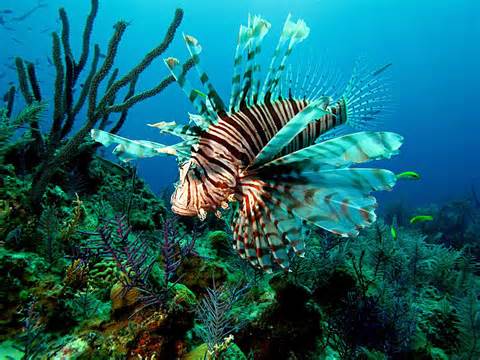 |
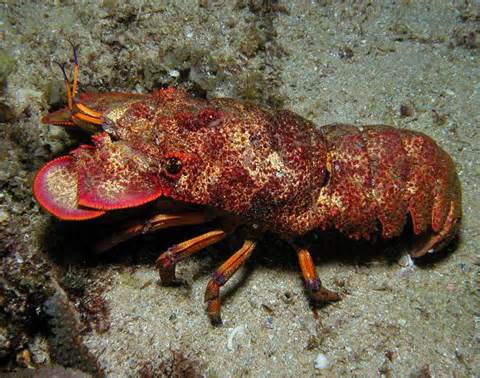
"Devil's Bowl" was an example of how
a reef can be destroyed. What once must have been
enormous coral heads were broken and lying in chunks on
the seabed. This could have been from any one of a
dozen causes, but the result was a dead reef. |
We had the pleasure of meeting Peter
Hughes again. He had just begun manufacturing a fog-free
dive mask and a new buoyancy control (BC) vest that was
impressive. Dad approached Peter and asked to see the new
BC. "See it...hell try it." So the next
day, Dad and Peter swapped vests. Dad later purchased the
vest from Peter and I have never seen the product line again.
Dad should have had it autographed.
We saw more octopi in St. Lucia than
anywhere else. A soft, silky, rubbery animal, the octopus
is highly intelligent. If you place a crayfish in a bottle
and cork it, the octopus will figure out a way to take the cork
out to get to its prey. On one occasion we got to see how
aggressive the animal can be. A tap on a tank caused us to
turn our heads towards the Dive Master (that was the universal
heads-up signal) who had spotted an octopus on an empty Crisco
bottle. When the Dive Master tried to take the bottle
away, the octopus put up a struggle. Their grace and
motion in the water is amazing.
We made a second trip to see Bupa on a
rainy day. Fortunately, rain doesn't delay diving.
After all, you are going to get wet anyway. It doesn't do
much for the lighting, but it does create a different effect
looking up as the rain dimples the surface.
Our last two dives were "Fairy Land" and "Anse
La Ray"; named for the town by the same name.
We bought our fair share of T-shirts and
trinkets for Mom and that night began the heartbreaking process
of packing to go home.
After a week in saltwater, our dive bags
and gear smelled as though something had wanted to sneak into
the U.S. and died along the way. The days following the
trip were consumed in getting the stink our of our clothes and
gear, explaining what photos were supposed to be, and beginning
the process of selecting the next dive trip. We were four
shades darker, four pounds heavier, and decades of experience
wealthier.
Back to

Back to

|